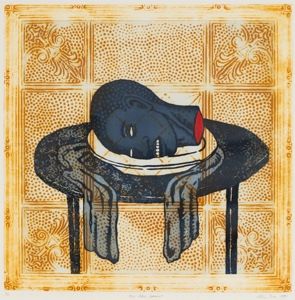Back to Gallery
 Saar, Alison, Blue Plate Special, 1993. Colour transfer lithograph and etching (soft-ground) with chine collé. Sheet: 24 x 24 inches (61 x 61 cm). Purchased with the Hunt Corporation Arts Collection Program, 1994.
Saar, Alison, Blue Plate Special, 1993. Colour transfer lithograph and etching (soft-ground) with chine collé. Sheet: 24 x 24 inches (61 x 61 cm). Purchased with the Hunt Corporation Arts Collection Program, 1994.
Given only a quick glance at her expression, it might seem like she’s only sleeping, but the reality of the etching is much more gruesome. A blue head, tilted slightly towards the viewer, lies in a white dish that sits on a low, black table. Wreathing the bowl is a long hand towel that had once guarded someone’s hands from the plate’s heat before being forgotten. The title ‘Blue Plate Special’ is a phrase historically used to refer to a cheap meal offered at North American diners, often part of the daily selection and served on pre-divided plates, but is at odds with the off-hand tone of the print. The ‘blue’ refers to the plate and the decapitated head of a nameless black woman and the title to a diner setting and a lonely, low table that is almost a stool, a meal and a body that is not a body. The head is offered up as a source of nourishment and an object to be taken apart and consumed— Saar literally represents the black female body, mind and very being (as represented by her head, the home of one’s personality, knowledge and humanity) as some strange fruit: of value but forgotten about, gruesome but bloodless, used but unwanted. That this woman is without a body, name or identity further flattens her; she is not an individual but rather a stand in for African American women at large, who permanently live in such liminal spaces.
Saar is well-known for this doublespeak; the re-appropriating of everyday objects, referred to as ‘found objects’, to offer many new and often conflicting meanings. Her depictions of the black body are almost never in earnest but rather ironic; black bodies are never in full but disembodied and decapitated. She said herself that the “floating heads may also be an act of denial of the self”. She is unable to render the black body fully as our ‘found objects’, given meaning by their history, are incapable of providing enough nuance.
Sources:
Farrington, Lisa E. “Reinventing Herself: The Black Female Nude.” Woman’s Art Journal, vol. 24, no. 2, 2003, p. 15. DOI.org (Crossref), doi:10.2307/1358782.
Reclaiming Histories: Betye and Alison Saar, Feminism, and the Representation of Black Womanhood. 2020, p. 41.
Schur, Richard. “Post-Soul Aesthetics in Contemporary African American Art.” African American Review, vol. 41, no. 4, Dec. 2007, p. 641. DOI.org (Crossref), doi:10.2307/25426982.